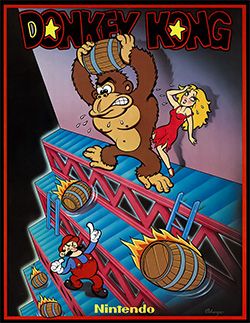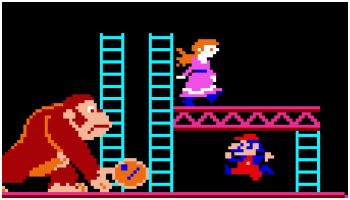 Bite-Sized Game History is a column of extremes. Sometimes, it’s a mind-blowing revelation that completely upends the way we think about some part of the distant past. And other times, it’s a fun piece of concept art from a 30-year-old video game.
Bite-Sized Game History is a column of extremes. Sometimes, it’s a mind-blowing revelation that completely upends the way we think about some part of the distant past. And other times, it’s a fun piece of concept art from a 30-year-old video game.
You’ll find both extremes in this edition of Bite-Sized Game History, as well as the story of the extreme measures that Mattel used to take to stress test the Intellivision.
![]() You can find a lot of dedicated video game historians on Twitter, and in 280 characters or less, they always manage to unearth some amazing artifacts. Bite-Sized Game History aims to collect some of the best stuff I find on the social media platform.
You can find a lot of dedicated video game historians on Twitter, and in 280 characters or less, they always manage to unearth some amazing artifacts. Bite-Sized Game History aims to collect some of the best stuff I find on the social media platform.
Between the tech industry’s increasing reliance on planned obsolescence and the debate over the right to repair, many people pine for the days when consumer electronics were (seemingly) built from more sturdy stuff. We might just be nostalgic for a time that never actually existed, but at least one console manufacturer put their prospective products through a literal trial by fire.
In the early 1980s, Mattel put consoles and computers from their Intellivision line through a series of stress tests before making them available on store shelves. The National Videogame Museum in Texas has acquired several of these samples, including the following machines that were subjected to an intense heat test:
Why are a bunch of melted #Intellivision systems sitting in the NVM? Good question! These units were part of an official Intellivision stress test to see how much heat they could withstand. As you can tell from the pictures, they found the limit eventually! #nvmusa pic.twitter.com/6fqUqYbnVZ
— National Videogame Museum (@nvmusa) September 1, 2020
Donkey Kong didn’t just kickstart Nintendo’s ascent into becoming a major player in the game industry, but it’s also one of the biggest titles to emerge from the “Golden Age of Arcade Games” and the aftereffects of its development have rippled out into every corner of video game history.
There’s the game’s original origin story as an adaptation of Popeye, the legend of Mario Segale’s fiery Italian temper and its ripple effect on a certain plumber, Universal’s legal gambit to shutdown the character (and Nintendo’s stunning victory), and the consolemaker’s decision to immortalize their lawyer from that case with the Kirby franchise.
Even developer Shigeru Miyamoto gets in on the mythmaking, as he loves to share the story of why Mario was given a hat and mustache in Donkey Kong. According to Miyamoto, the hat was added so that Nintendo’s programmers wouldn’t have to animate his hair and a few small pixels were pasted in for a mustache to simulate a better outline for Mario’s nose and mouth on the game’s small screen. But there is also another path snaking away from Donkey Kong‘s creation that will possibly rewrite how you perceive the creation of Mario’s signature look.
In this thread, historian Kate Willaert ties together everything you think you know about the game before completely blowing it all up again with an absolutely bonkers (but perfectly plausible) new theory:
Mario trying to look LA-cool looks kind of funny…but the connection to Los Angeles fashion also hints at a rarely talked about aspect of his origin.
This is a thread. pic.twitter.com/jp6EZrZy9w
— "Critical Kate" Willært ?? (@katewillaert) September 23, 2020
It’s impossible to follow up that thread with anything equally as impressive, so let’s switch gears and look at a few pieces of concept art from the original Battletoads.
Dlala Studios brought the franchise back a few months ago with a brand new art style that seems to be heavily inspired by the Saturday morning cartoons that inspired the NES original. But Rare didn’t have the luxury of today’s development tools and instead took a first pass at the characters on good old pencil-and-paper. Developer Paul Machacek shared some of the art created by Kev Bayliss, including a very early look at the infamous headbutt attack:
Now something special. Hidden in a folder for ~30 years original #Battletoads artwork by @Kev_Bayliss from the original BT games from @RareLtd #rareware. Animated frames started off like this & then got shrunk to fit in a few sprites on #NES & #Gameboy pic.twitter.com/EtjXh91w2q
— Paul Machacek (@Paul_Mach1) October 3, 2020
That’s it for this edition of Bite-Sized Game History. And if you need me, I’ll be sitting quietly in a chair still trying to wrap my head around all the connections between Popeye (the cartoon), Donkey Kong, Popeye (the magazine), and Mario.

